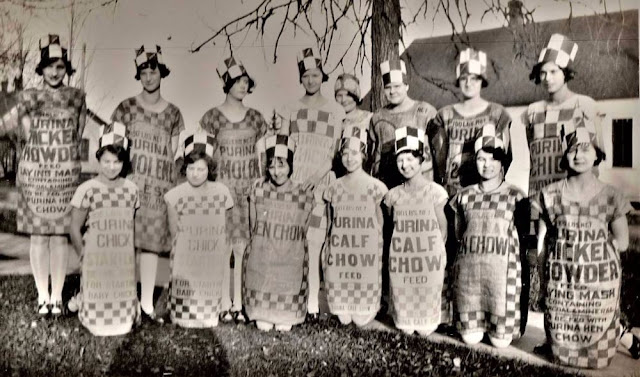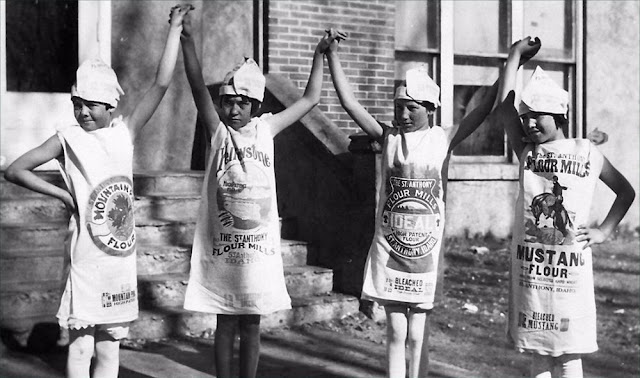Back in the 1930s, flour companies began noticing that women were turning their cotton flour sacks into clothing, diapers, dish cloths and more. Times were hard and the companies decided to help families out by packaging their flour in beautiful patterns.
“Repair, reuse, make do, and don't throw anything away” was a motto during the Great Depression. Very few farm families had enough money to buy new clothes at a store. Mothers mended socks and sewed patches over holes in clothes. Clothes were "recycled" and reused as younger children "made do" with hand-me-downs. When farmers brought home big sacks of flour or livestock feed, farm women used the sacks as material to sew everything from girls' dresses to boys' shirts and even underpants.
Sack clothing was popular for hard-pressed prairie farmers, in both Canada and the United States, in the 1920s, more so in the Great Depression of the 1930s, and even into the 1950s. Sometimes referred to as “feedsack,” or even “chicken linen,” the most commonly used for clothing were cotton flour and sugar sacks.
![]()
While conditions were worst in the 1930s, farm distress was not unusual in the 1920s. Cotton shortages in the Second World War brought a revival of sack clothing, particularly dresses.
![]()
In the 1950s, sugar and flour mills began to package their products in less costly paper bags, bringing an end to sack clothing.
Learn about the ingenious way in which women of the 1930s transformed mundane flour sacks into stylish garments, using the vibrant patterns as their guide.
![]()
Delight in the revelation that flour sacks in the 1930s were not just utilitarian, but also fashionable, with eye-catching patterns that inspired women to create their own dresses.
Reveal the hidden fashion trend of the 1930s as you learn about the unique practice of women using flour sacks and their vibrant patterns to sew their own dresses.
Witness the intersection of practicality and artistry in the 1930s, as women discovered the beauty in flour sacks’ colorful patterns and transformed them into stunning dresses.
Embark on a journey of fashion history and uncover the surprising fact that flour sacks from the 1930s provided women with the means to express their creativity through DIY dressmaking.
Rediscover the forgotten art of flour sack dressmaking in the 1930s, where women skillfully utilized the vibrant patterns to fashion unique and stylish dresses.
This allowed imaginative and thrifty home sewers to upcycle the fabric into dresses, aprons, quilts and other household items.
![]()
Feed sack dresses became a popular DIY fashion staple to withstand hard times
Feed sacks featured imaginative prints like storybook characters, garden scenes, and geometric shapes
Vintage feed sack garments and quilts are now coveted by collectors as folk art reflecting 1930s ingenuity.
These feed sack artifacts provide a glimpse into thrifty 1930s culture born of hardship but full of artistry
Through upcycling and repurposing, feed sacks were given renewed life and newfound artistic purpose
Feed sack DIY fashion stands as a testament to the creativity and resilience of Depression-era women.
Vibrant feed sacks provided a canvas for creative self-expression through sewing and quilting.
Feed sack fashion captures the resourcefulness and craftiness of American women during lean times.
The vibrant ink patterns transformed plain flour sacks into fabrics bursting with color and whimsical motifs.
Like patches on a quilt, feed sack prints stitched together stories of hardship, creativity, and resilience.
Feed sack fashion reflects the resourcefulness and self-sufficiency gained by women due to 1930s austerity.




























